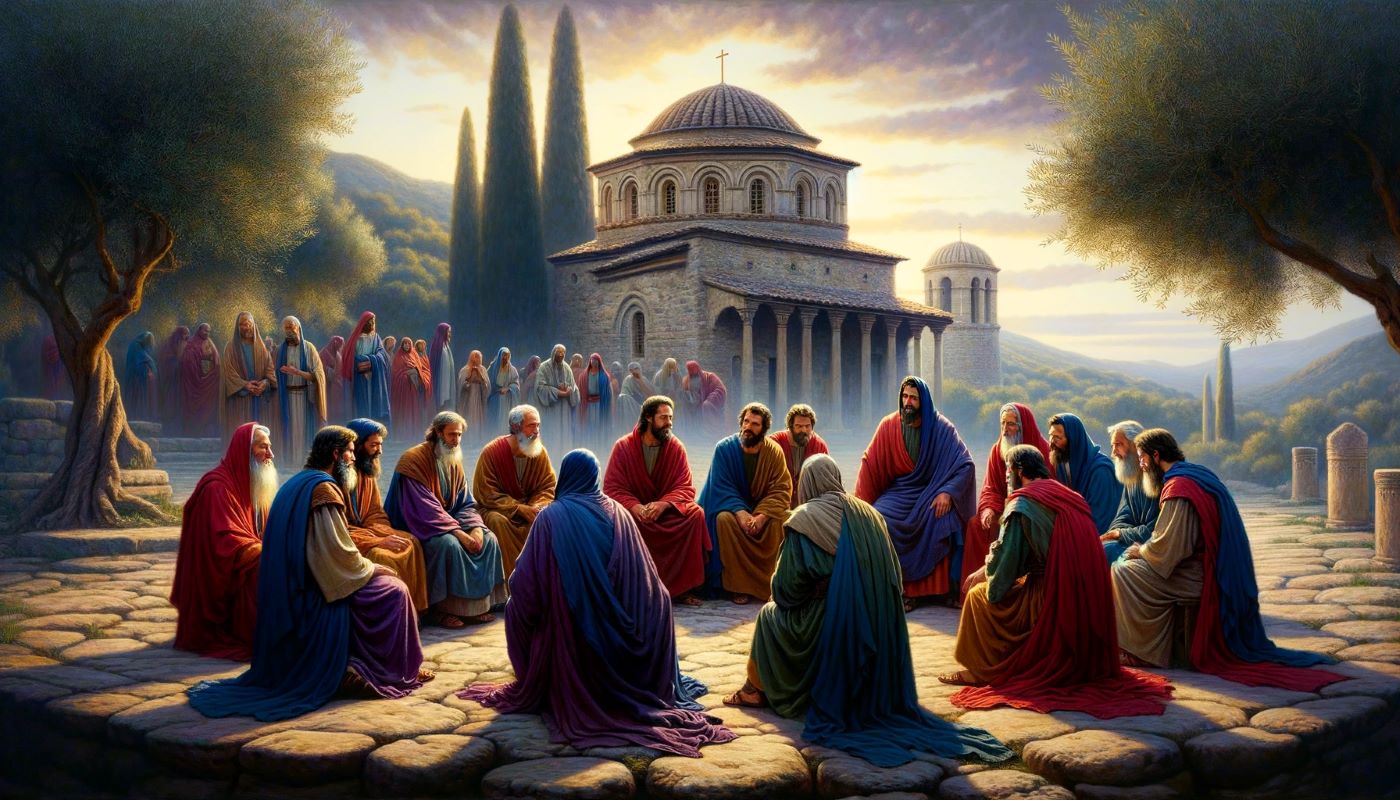Home>Bible Facts>What Color Do Apostles Wear


Bible Facts
What Color Do Apostles Wear
Published: February 17, 2024
Peter Smith, Editorial Director at Christian.net, combines deep insights into faith, politics, and culture to lead content creation that resonates widely. Awarded for his contributions to religious discourse, he previously headed a major organization for religious communicators, enhancing dialogue on faith's societal impacts.
Discover the significance of the colors worn by apostles in the Bible. Uncover fascinating Bible facts about apostles' attire and its symbolism.
(Many of the links in this article redirect to a specific reviewed product. Your purchase of these products through affiliate links helps to generate commission for Christian.net, at no extra cost. Learn more)
Table of Contents
Introduction
The clothing of religious figures has long been a subject of fascination and curiosity. In the context of Christianity, the attire of the apostles holds particular significance, as it is intertwined with historical, cultural, and symbolic elements. Exploring the colors associated with the clothing of apostles unveils a rich tapestry of tradition, spirituality, and interpretation.
The apostles, as central figures in the New Testament, are revered for their pivotal roles in spreading the teachings of Jesus Christ. Their attire, while not extensively documented in historical texts, has been a subject of contemplation and interpretation within Christian communities. The colors associated with their clothing have sparked discussions and varying perspectives, adding depth to the understanding of their significance.
Delving into the historical context and symbolism of the colors attributed to the apostles' clothing provides a gateway to comprehending the cultural and spiritual nuances embedded in Christian traditions. By examining the diverse interpretations across different denominations and regions, we gain insight into the multifaceted nature of this topic.
This exploration aims to shed light on the colors associated with the clothing of the apostles, offering a nuanced understanding of their potential significance within the broader framework of Christian belief and practice. By delving into the historical background, symbolism, and variations in different traditions, we embark on a journey of discovery that unveils the profound layers of meaning woven into the fabric of the apostles' attire.
Read more: What Do Baptist Clergy Wear?
Historical Background of Apostles' Clothing
The historical background of the apostles' clothing is a subject that intertwines with the cultural and societal context of the time. During the era in which the apostles lived and carried out their ministries, clothing held significant cultural and religious symbolism. The attire worn by individuals often conveyed their social status, occupation, and religious affiliation. In the case of the apostles, their clothing would have reflected the norms and customs of the regions they traversed while spreading the teachings of Jesus Christ.
The apostles, hailing from diverse backgrounds and professions, would have worn clothing typical of their respective societal roles. For instance, fishermen such as Peter and Andrew would have likely donned attire suitable for their occupation, while individuals from urban areas might have worn garments reflecting city life. It is important to note that the apostles were not distinguished by any specific uniform or distinct attire, as their focus was on their spiritual mission rather than outward appearances.
The historical context of the apostles' clothing also intersects with the broader cultural milieu of the ancient Mediterranean world. This region was characterized by a rich tapestry of clothing styles, materials, and colors, each carrying its own significance. The attire worn by the apostles would have been influenced by these cultural norms, reflecting the diversity and complexity of the societies they encountered during their travels.
Furthermore, the historical background of the apostles' clothing is intertwined with the practical considerations of their itinerant lifestyle. As they journeyed from place to place, the apostles would have adapted their attire to suit varying climates and environments. Their clothing would have been functional, providing protection and comfort as they navigated different terrains and climates while spreading the message of Christianity.
In essence, the historical background of the apostles' clothing offers a glimpse into the multifaceted nature of their attire, shaped by cultural, practical, and societal factors. While specific details about their clothing may not be extensively documented, understanding the historical context enriches our appreciation of the apostles' lived experiences and the diverse cultural tapestry within which they carried out their mission.
Symbolism of Colors in Christianity
Colors hold profound symbolic significance within the realm of Christianity, serving as potent conveyors of spiritual meaning and theological concepts. Each hue is imbued with layers of symbolism that resonate deeply within Christian traditions, enriching the visual and sensory dimensions of religious expression. The symbolic significance of colors in Christianity is rooted in both biblical narratives and historical interpretations, shaping the way believers perceive and engage with the divine.
Red, a color synonymous with passion, sacrifice, and the blood of Christ, embodies the fervent love and selflessness exemplified by Jesus' crucifixion. It symbolizes the atoning sacrifice and the outpouring of divine love, evoking a profound sense of redemption and spiritual vitality. In the context of the apostles, red may symbolize their unwavering commitment to spreading the Gospel, often amidst persecution and martyrdom.
Blue, with its association with the heavens and the divine, represents transcendence, truth, and the boundless expanse of God's grace. It conveys a sense of spiritual depth and contemplation, inviting believers to gaze upward and ponder the mysteries of faith. Within the narrative of the apostles, blue may signify the celestial nature of their mission, as they carried the message of salvation to distant lands and diverse cultures.
White, a symbol of purity, holiness, and divine illumination, reflects the radiance of God's presence and the transformative power of grace. It signifies the triumph of light over darkness and serves as a visual reminder of the purity and righteousness sought by followers of Christ. In relation to the apostles, white may embody the spiritual purity and sanctity of their calling, as they were chosen to bear witness to the transformative message of the Gospel.
Green, evoking images of growth, renewal, and abundance, symbolizes the vitality of faith and the flourishing of spiritual life. It represents the ever-renewing cycle of grace and the nurturing care of God, fostering a sense of hope and resilience. Within the context of the apostles, green may symbolize the enduring growth and propagation of the Christian faith, as they sowed the seeds of belief in diverse communities.
The symbolism of colors in Christianity extends beyond these examples, encompassing a rich spectrum of hues, each carrying its own theological resonance. As such, the colors associated with the apostles' clothing may evoke diverse symbolic interpretations, reflecting the multifaceted nature of their spiritual legacy and the enduring impact of their ministry.
The Color of Apostles' Clothing in Different Traditions
The color of the apostles' clothing varies across different Christian traditions, reflecting the diverse cultural, historical, and theological perspectives within the global Christian community. These variations offer a fascinating glimpse into the rich tapestry of beliefs and practices that have evolved over centuries, shaping the visual and symbolic representations of the apostles' attire.
In Eastern Orthodox traditions, the depiction of the apostles often features vibrant and richly symbolic colors. Gold, symbolizing the radiance of the divine, is frequently used to adorn the robes of the apostles, conveying their elevated spiritual status and their role as bearers of the sacred message. Additionally, deep hues such as royal blue and crimson red are employed to underscore the regal and transcendent nature of their ministry, evoking a sense of awe and reverence. These colors reflect the Eastern Orthodox emphasis on the majestic and transcendent aspects of Christian faith, infusing the portrayal of the apostles with a sense of divine splendor and grandeur.
In Western Christian traditions, particularly within Roman Catholic and Protestant denominations, the colors associated with the apostles' clothing may exhibit distinct nuances. The attire of the apostles is often depicted in more subdued and earthy tones, reflecting a focus on humility, simplicity, and earthly embodiment. Earthy browns, muted greens, and soft blues may be used to convey a sense of groundedness and human connection, emphasizing the apostles' role as relatable and compassionate messengers of the Gospel. These colors align with the emphasis on the humanity and approachability of the apostles within Western Christian traditions, underscoring their capacity to empathize with the joys and struggles of humanity.
Furthermore, within the context of cultural and regional variations, the colors associated with the apostles' clothing may exhibit further diversity. In some traditions, specific hues may hold cultural or historical significance, reflecting the unique interpretations and artistic expressions prevalent within distinct Christian communities. These variations enrich the visual and symbolic landscape of the apostles' attire, offering a testament to the dynamic interplay between faith, culture, and artistic representation.
In essence, the color of the apostles' clothing in different traditions reflects the multifaceted nature of Christian belief and practice, encompassing a spectrum of interpretations and visual expressions. These variations serve as a testament to the enduring impact of the apostles' legacy, resonating across diverse cultures and traditions, and inviting contemplation on the rich tapestry of Christian spirituality.
Conclusion
The exploration of the colors associated with the clothing of the apostles unveils a tapestry woven with historical, cultural, and symbolic threads, enriching our understanding of the multifaceted nature of Christian traditions. The historical background of the apostles' attire provides a window into the diverse cultural and societal contexts within which they carried out their ministries, reflecting the practical, cultural, and regional influences that shaped their clothing. While specific details about their attire may not be extensively documented, the historical backdrop offers valuable insights into the lived experiences of the apostles and the rich diversity of the ancient Mediterranean world.
Furthermore, the symbolic significance of colors in Christianity illuminates the profound theological dimensions embedded within the hues associated with the apostles' clothing. Each color carries layers of meaning, evoking themes of sacrifice, transcendence, purity, and vitality, enriching the visual and sensory dimensions of religious expression. The symbolic resonance of these colors invites contemplation on the spiritual legacy of the apostles and the enduring impact of their ministry across diverse cultures and traditions.
The variations in the depiction of the apostles' clothing across different Christian traditions reflect the dynamic interplay between faith, culture, and artistic representation. From the vibrant and regal hues in Eastern Orthodox traditions to the subdued and earthy tones in Western Christian denominations, the diverse visual expressions underscore the rich tapestry of beliefs and practices that have evolved over centuries. These variations serve as a testament to the enduring legacy of the apostles, resonating across diverse cultures and inviting contemplation on the rich tapestry of Christian spirituality.
In conclusion, the colors associated with the clothing of the apostles offer a gateway to deeper insights into the historical, cultural, and symbolic dimensions of Christian traditions. This exploration invites us to contemplate the enduring legacy of the apostles and the diverse ways in which their ministry continues to inspire and resonate within the global Christian community. As we ponder the colors of the apostles' attire, we embark on a journey of discovery that unveils the profound layers of meaning woven into the fabric of their spiritual legacy, enriching our appreciation of the enduring impact of their ministry.















